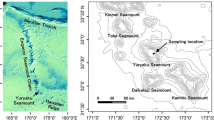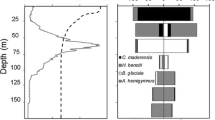Abstract
The vertical distribution of seven sternoptychid species was examined from RMT 1+8 samples collected aboard R. V. “Meteor” in March-April 1979 and from Royal Research Ship R.R.S. “Discovery” in July 1974 in the central equatorial Atlantic. During daytime sternoptychids occupied depths between 200 and 1250 m, with Sternoptyx pseudobscura living deepest, centering between 800 and 900 m, and Argyropelecus sladeni most shallow, aggregating predominantly at 300 and 400 m. They are all considered limited or partial migrants, ascending only some 100 and 200 m towards the surface at night. Only A. sladeni was observed to enter the epipelagic zone (0 and 200 m).-Feeding patterns were investigated from stomach content analyses of Sternoptyx diaphana, S. pseudobscura, Argyropelecus sladeni and A. affinis. Additional stomach contents were analysed from samples of S. diaphana, A. hemigymnus and A. olfersi collected in June 1985 from F.R.V. “Walther Herwig” in the temperate NE Atlantic at 46°N, 17°W by means of the Engel Trawl. The food spectrum of the six species is generally described, and additional dietary evidence regarding calanoid copepod prey is provided for four of these taxa. All sternoptychid species investigated were planktivorous, feeding predominantly on copepods and ostracods, except for the largest size class, which preyed heavily on euphausiids and amphipods. The relationship of predator size towards prey type and prey size is analysed for both Sternoptyx species. Of these, S. pseudobscura in particular exhibits taxonomic selectivity towards polychaete prey. The diet of both species of Sternoptyx included a number of epipelagic or even neustonic calanoid copepod species which contributed more than 50% of the total copepod population by numbers. So far it is not known how the predators find access to prey organisms of the upper 200 m, as netfeeding is considered unlikely. Cyclopoid copepods of the genus Sapphirina were observed as dietary component particular of S. diaphana.
Similar content being viewed by others
Literature cited
Badcock, J., Baird, R. C. (1980). Remarks on systematics, development and distribution of the hatchetfish genus Sternoptyx (Pisces, Stomiatoidae). Fish. Bull. U. S. 77: 803–820
Baird, R. C. (1971). The systematics, distribution, and zoogeography of the marine hatchetfishes (Fam. Sternoptychidae). Bull. Mus. comp. Zool. Harv. 142: 1–128
Baker, A. de C., Clarke, M. R., Harris, M. J. (1973). The NIO combination net (RMT 1+8) and further developments of rectangular midwater trawls. J. mar. biol. Ass. U.K. 53: 167–184
Bradbury, M. g. et al. (1970). Studies on the fauna associated with the deep scattering layers in the equatorial Indian Ocean, conducted on R/V TEVEGA during October and November 1964. In: Proc. int. Symp. Biol. Sound Scattering in the Ocean, p. 409–452 [Farquhar, G. B. (ed.) M.C. Rep., Wash. D.C.]
Brooks, A. L. (1977). A study of the swimbladders of selected mesopelagic fish species. In: Anderson, W. L., Zahuranec, B. J. (eds.) Oceanic sound scattering prediction. Plenum Press, New York, p. 565–590
Clarke, Th. A. (1978). Diel feeding patterns of 16 species of mesopelagic fishes from Hawaiian waters. Fish. Bull. U.S. 76: 495–513
Farquhar, G. B. (1977). Biological sound scattering in the oceans: A review. In: Farquhar, G. B. (ed.) Proc. int. Symp. Biol. Sound Scattering in the Ocean, M. C. Rep., Wash. D. C., p. 493–527
Gjösaeter, J. (1973). The food of the myctophid fish, Benthosema glaciale (Reinhardt), from western Norway. Sarsia 52: 53–58
Gorelova, T. A. (1978). Nutrition of the luminescent anchovis Ceratoscopelus warmingii (LÜTKEN) and Bolinichthys longipes (BRAUER), Fam. Myctophidae in the western equatorial part of the Pacific Ocean. J. Ichthyol. 18: 673–683
Heron, A. C. (1973). A specialized predator-prey relationship between the copepod Sapphirina angusta and the pelagic tunicate Thalia democratica. J. mar. biol. Assoc. U.K. 53: 429–435
Hopkins, T. L., Baird, R. L. (1973). Diet of hatchetfish Sternoptyx diaphana. Mar. Biol. 21: 34–46
Hopkins, T. L., Baird, R. C. (1977). Aspects of the feeding ecology of oceanic midwater fishes. In: Anderson, W. R., Zahuranec, B. J. (eds.) Ocenic sound scattering prediction. Plenum Press, New York, p. 325–360
Hopkins, T. L., Baird, R. C. (1985). Feeding ecology of four hatchet fishes (Sternoptychidae) in the eastern Gulf of Mexico. Bull. Mar. Sci. 36: 260–277
Howell, W. H., Krueger, W. H. (1987). Family Sternoptychidae. Marine hatchetfishes and related species. In: Gibbs, R. H., Krueger, W. H. (eds.) Biology of midwater fishes of Bermuda ocean acre: Smithsonian Contr. Zool. Wash., D. C., No. 452, p. 32–50
Kinzer, J. (1982). The food of four myctophid fish species off Northwest Africa. Rapp. P.-v. Réun. Cons. int. Explor. Mer 180: 378–383
Kinzer, J. and Schulz, K. (1985). Vertical distribution and feeding patterns of midwater fish in the central equatorial Atlantic. I. Myctophidae. Mar. Biol. 85: 313–322
Lancraft, T. M., Robison, B. H. (1980). Evidence of post capture ingestion by midwater fishes in trawl nets. Fish. Bull. U.S. 77: 713–715
Marshall, N. B. (1951). Bathypelagic fishes as sound scatterers in the ocean. J. mar. Res. 10: 1–17
Marshall, N. B. (1960). Swimbladder structure of deep-sea fishes in relation to their systematics and biology. Discovery Rep. 31: 1–122
Merrett, N. R., Roe, H. S. J. (1974). Patterns and selectivity in the feeding of certain mesopelagic fishes. Mar. Biol. 28: 115–126
Roe, H. S. J., Badcock, J. (1984). The diel migrations and distributions within a mesopelagic community in the North East Atlantic. 5. Vertical migrations and feeding of fish. Prog. Oceanogr. 13: 389–429
Tyler, H., R., Pearcy, W. G. (1975). The feeding habits of three species of lanternfishes (Family Myctophidae) off Oregon, USA. Mar. Biol. 32: 7–11
Author information
Authors and Affiliations
Additional information
Communicated by O. Kinne, Oldendorf/Luhe
Rights and permissions
About this article
Cite this article
Kinzer, J., Schulz, K. Vertical distribution and feeding patterns of midwater fish in the central equatorial Atlantic II. Sternoptychidae. Mar. Biol. 99, 261–269 (1988). https://doi.org/10.1007/BF00391989
Accepted:
Issue Date:
DOI: https://doi.org/10.1007/BF00391989




